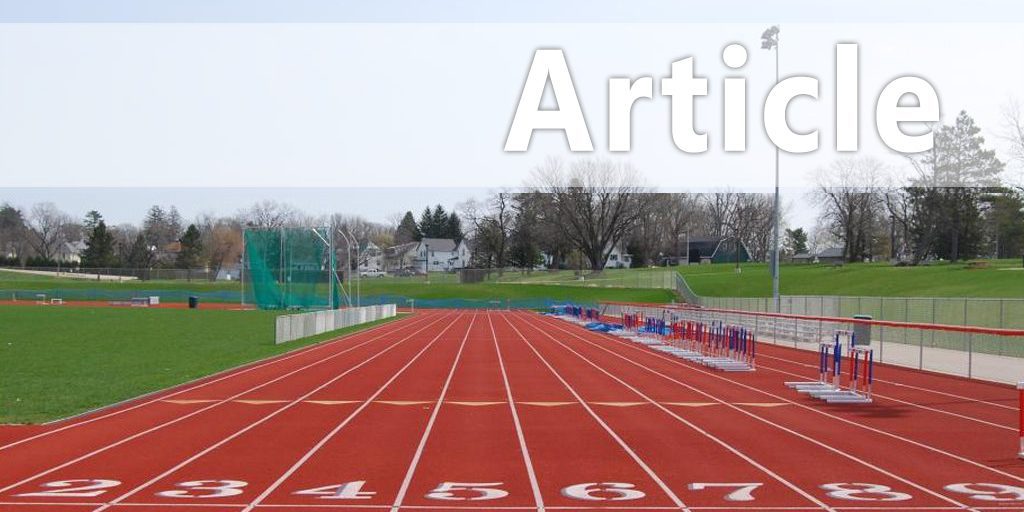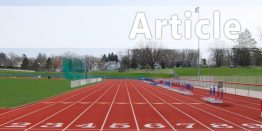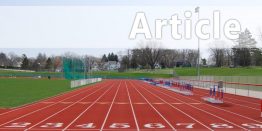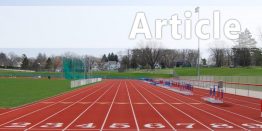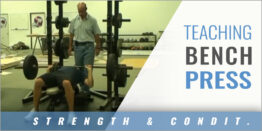|
Simplified Coaching in the Sprint Hurdles By: Boo Schexnayder Provided by: Schexnayder Athletic Consulting - SacSpeed.org
Coaching the sprint hurdles can be a daunting task... many variables and few constants. Here we ease coaching by developing a simple coaching system for the 100 and 110 hurdles. The key to simplifying the hurdles, as in any other technical event, lies in cause and effect coaching. Many aspects of hurdle technique occur naturally when other the essential aspects are correct, so we can focus on these essentials and shorten our list of coaching tasks. Fundamentals of Hurdling Driving Out. The hurdle race begins with driving strides. These driving strides are strong steps with less than maximal frequency, and should give the athlete the same sensation one gets when sprinting uphill. Takeoff Location. Boys should takeoff 7 feet from the hurdle, while girls should take off 6'6" from the hurdle. Many errors in hurdling result because the takeoff occurs too close to the hurdle (taking off too far away seldom happens). An important part of coaching hurdles is monitoring the distance from the hurdle at takeoff. Takeoff. To initiate the hurdle takeoff, the takeoff foot is planted under the hips (planting the foot in front of the hips is a common error). During takeoff, the hips must displace in a forward direction toward the hurdle, so that when the hurdler leaves the ground, the hips are significantly in front of the takeoff foot. Pelvic Posture. Throughout the hurdle race, the pelvis should remain in a neutral, balanced position. Most postural errors in hurdling occur because the hurdler bends at the waist to clear the hurdle. This unbalances the pelvis and reduces hurdling efficiency. While body lean into the hurdle is needed at times, this lean must be a lean of the entire body, rather than flexion at the waist. Between hurdles, the pelvis must be kept high, away from the track surface. The Lead Leg. In hurdling, nearly all lead leg problems are caused by poor pelvic posture or by being too close to the hurdle at takeoff. To simplify the system, we will ignore the effect (the lead leg) and focus on the causes (posture and takeoff location) The Trail Leg. The quality of the trail leg action in the hurdles is determined entirely by the displacement achieved at takeoff. During takeoff, when the hips move past the takeoff foot, the hip flexor muscles in the trail leg are stretched. The response to this stretch is an elastic rebounding action that initiates the trail leg movement. Labored trail legs always result from poor displacement, because these stretch reflexes are not present. Proper location of takeoff is prerequisite to a good trail leg, because if the hurdler is too close to the hurdle, the displacement (and hip flexor stretches) cannot take place. To simplify the system, we will ignore the trail leg action (the lead leg) and focus on the prerequisites we have identified (displacement and takeoff location). Arm Action. The function of the arms in hurdle clearance is to balance the actions and rotations of the hips and legs. The arms are symptomatic. Arm problems are caused by faulty movements of the lower body, particularly poor pelvic posture. Wild arms are always associated with unlevel or low hips. We will simplify our system by ignoring the arms (the effect) and again addressing the causes. Hurdle Cues and Coaching Practices "Feel Your Trail Leg Behind You". Telling athletes to feel the trail leg behind during takeoff teaches them to displace and sets up the hip flexor stretches we need. An added benefit of this cue is that hurdlers anticipate it at takeoff and as a result, do a better job of planting the takeoff foot under the hips. "Stay Up As You Hurdle". This cue is used with hurdlers who bend at the waist excessively and lose pelvic posture as a result. The hips should be kept up, distant from the surface. Understanding Stride Length and Frequency Relationships. Stride length and frequency are inversely proportional. When stride frequency increases, strides become shorter. When stride frequencies slow, strides become longer. Quicker steps are shorter steps, driving steps are slower and longer steps. Using the Trail Leg to Determine Takeoff Location. If the hurdler takes off from the correct location, the trail leg will come through quickly, but late. When standing behind the hurdler, the coach will notice the trail leg action occurs immediately after the lead leg action when the takeoff is too close. When takeoff location is correct, there will be a noticeable time differential between the lead and trail leg actions. The System The Approach to the First Hurdle. The coach assumes a position beside the first hurdle. With the first hurdle down and the takeoff location marked, have the athlete drive out for four steps, and then begin to quicken stride frequency. Note the location of the 8th (takeoff) step. For most athletes, this will place them very close to the correct location. If the takeoff location is incorrect, then we use our understanding of stride length/frequency relationships to make adjustment. For example, if takeoff is too far from the hurdle, have the hurdler drive out for 5 before quickening. If too close, begin quickening after 3 drive steps. Running and Evaluating the Hurdles. The coach then asks the athlete to clear the first hurdle. After running the first hurdle a few times, progressively add hurdles one at a time until the maximum number of hurdles to be used in the workout is reached. Each hurdle clearance will require the coach to evaluate two components, posture and takeoff location. Evaluating Posture. The coach moves to a position behind the blocks, and the hurdler rehearses the approach to and over the first hurdle. The coach carefully observes the athlete's beltline. If the athlete bends at the waist on any hurdle, the belt line will tilt (downward on the lead leg side) and remain tilted for the remainder of the run. When this occurs, the coach instructs the athlete to stay up while hurdling. In extreme cases it may be necessary to lower the hurdles until the improved posture is stable. Evaluating Takeoff Location. Observe the time differential between the lead and trail legs to evaluate takeoff location. If the hurdler is too close to the hurdle and the hurdler's trajectory is appropriate, the coach uses the stride length/frequency relationships to make adjustments. It is typical to cue hurdlers to quicken up between the hurdles to prevent the hurdler from getting too close. If the hurdler is too close and too high, the coach cues the hurdler to feel the trail leg behind the body at takeoff. Other Issues and Problems in Hurdle Coaching Hitting Hurdles. Hitting hurdles in a race is usually related to low hips, so cue the hurdler to stay up between the hurdles. Bailing Out. Normally bailing out results when the hurdler is too far away from the hurdle. The coach should use the same stride length/frequency relationships to correct this problem. Lower stride frequency and increased drive are the answer here. Discounting the Hurdles. Hurdling success is dependent upon fast rhythms. It does no good for hurdlers to lumber slowly through the hurdles in the early stages of learning. For this reason, it is standard coaching practice to use shortened hurdle spacings and hurdles that are lower than regulation height in training. These adjustments might be extreme with novice hurdlers. As the athlete gains proficiency, the hurdle spacings and heights used in training can more resemble those used in competition. Even the best hurdlers use slightly reduced heights and spacings at all times in training. Closing This system is capable of handling nearly all of the issues hurdlers face, either directly or indirectly. This system also has the added advantage of simplifying things for the athlete as well as the coach. Using a simple, consistent coaching system enables the athlete to become a better student of the event and make smart adjustments at times when the coach might not be nearby, developing confidence and fostering success.
|
